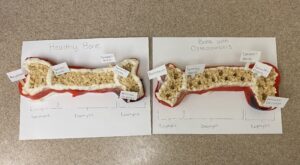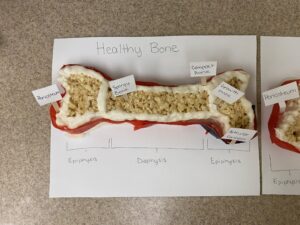


My project is a representation of corticosteroid induced osteoporosis. The overall object of this project is to go over how the stages of bones development and repair can be disrupted using corticosteroids. My diagram shows the bone markings of two different types of bones. One is a healthy bone before corticosteroid use, this bone shows the periosteum (Red Fruit by the Foot), which covers the outer surface of the bone and contains blood vessels, nerves, and lymphatic vessels that nourish compact bone. Articular cartilage (Blue Fruit by the Foot), which covers where the epiphyses meets other bones to form joints; helping to reduce friction and shock. Compact bone (White Chocolate) found under the periosteum, is known for being the dense to provide protection and strength to bones. Spongy bone (Rice Krispies), also known as cancellous bone, containing osteocytes housed in a network of matrix spikes called trabeculae. And an Epiphyseal line (White Chocolate), (former growth plate), an osseous tissue that replaced cartilage once the bone stops growing. The second diagram depicts a bone with osteoporosis. In this diagram you can see the difference as the compact bone has become much thinner and less trabeculae in cancellous bone making the appearance of larger holes.
Linked below is my Essay:

Sam’s project is focused on the objective of knowing and describing the stages of bone development and repair. The diagram she created took advantage of different snack foods to show how corticosteroid induced osteoporosis affects bone growth and development. The diagram consists of two edible bone models that display the physical differences between a healthy bone and a bone with osteoporosis, including labels on both bones pointing out the parts of bone and the key differences. In her essay, Sam lists each of the different foods she used and what they biologically represent. The Red Fruit by the Foot is the periosteum, which covers the outside surface of the bones and is home to blood vessels, nerves, and routes of the lymphatic system. The Blue Fruit by the Foot is the articular cartilage, which is present at joints where bones come in contact with each other. The White Chocolate represents compact bone, which provides strength to bones through density. The Rice Krispies represent spongy bone, which is where osteocytes are found in a matrix of trabeculae. Finally, a second line of White Chocolate, which is the Epiphyseal line, an osseous tissue that sits in a spot once occupied by cartilage. She then goes on to describe how corticosteroids, an anti-inflammatory drug used to treat autoimmune disorders among other conditions, can cause osteoporosis during long term use as the rate of bone resorption exceeds the rate of bone formation. The steroids interfere with the resorption of calcium and vitamin D, so the hormone Calcitonin cannot be activated to block osteoclast activity, causing bone tissue to be broken down and bone mass to decrease. Her diagram shows the large holes in the spongy bone caused from the lack of trabeculae. Sam goes on to explain the four phases of bone remodeling and how corticosteroids decrease the levels of estrogen and testosterone released in the body, which directly affect osteoblast activity and bone growth. Overall, Sam’s project was very clear and easy to understand. I really enjoyed that she used food to create the bones, because it made it simple to see the structural differences between the healthy bone and the bone with osteoporosis. Sam’s essay was also very informative and well researched, as it covered all the different aspects of how corticosteroids can cause life-long damage to bone structure. This project was by far the tastiest!